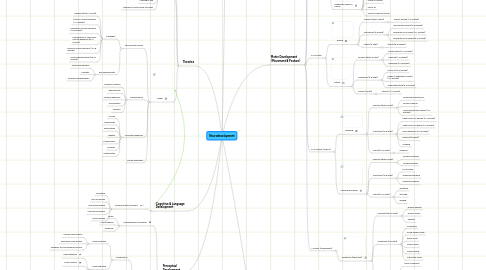
1. Spatiotemporal adaptation
1.1. Nervous system maturation
1.2. Environment
1.2.1. Space
1.2.2. Time
1.3. Adaptation
1.3.1. Development
1.3.2. Purposeful sequences of activity
1.3.3. Sensorimotor-sensory (SMS)
1.3.3.1. Assimilation
1.3.3.2. Accommodation
1.3.3.3. Association
1.3.3.4. Differentiation
1.4. Spiralling Continuum
1.4.1. Stress
1.4.2. Distress
2. Perceptual Development
2.1. Somatosensory Perception
2.1.1. Tactile
2.1.2. Proprioceptive
2.1.3. Vestibular
2.2. Visual Perception
2.2.1. Components
2.2.1.1. Visual receptive
2.2.1.1.1. Primary visual system
2.2.1.1.2. Secondary visual system
2.2.1.1.3. Pathways for eye movement control
2.2.1.2. Visual cognitive
2.2.1.2.1. Visual attention
2.2.1.2.2. Visual memory
2.2.1.2.3. Visual discrimination
2.2.1.2.4. Visual integration (VMI)
2.2.2. Types
2.2.2.1. Object (Form) Perception
2.2.2.1.1. Figure-ground
2.2.2.1.2. Form constancy
2.2.2.1.3. Visual closure
2.2.2.2. Spatial Perception
2.2.2.2.1. Depth perception
2.2.2.2.2. Position in space
2.2.2.2.3. Spatial relationships (topographical orientation)
3. Perceptual Motor Integration
3.1. What's involved (model)
3.1.1. Sensory stimulus
3.1.2. Sensory reception & processing
3.1.3. Sensory integration
3.1.4. Motor planning
3.1.5. Motor execution
3.1.6. Feedback
3.2. Qualities
3.2.1. Sensory perceptual function
3.2.2. Motor
3.2.2.1. Gross motor
3.2.2.2. Fine motor
3.2.3. Spatial Dimensions
3.2.3.1. Spatial awareness
3.2.3.1.1. Self in space
3.2.3.1.2. Use of space
3.2.3.2. Directional awareness
3.2.3.2.1. Laterality
3.2.3.2.2. Directionality
3.2.3.3. Body awareness
3.2.3.3.1. Body scheme
3.2.3.3.2. Body image
3.2.4. Spatial relationships
3.2.5. Temporal awareness
3.2.5.1. Timing
3.2.5.2. Rhythm
3.3. Perceptual Motor & Symbolic Development
3.3.1. Concrete reality
3.3.2. Symbolic development
4. Cognitive & Language Development
4.1. Communication Disorders
4.1.1. Dysarthria
4.1.2. Broca's aphasia
4.1.3. Wernicke's aphasia
4.1.4. Conduction aphasia
4.1.5. Global aphasia
5. Theories
5.1. Erikson
5.1.1. Trust vs Mistrust (0-18 months)
5.1.2. Autonomy vs Shame & Doubt (2-4 years)
5.2. Havighurst
5.2.1. Learning to communicate wants & refusals
5.2.2. Learing to walk
5.2.3. Learning to take solid food
5.2.4. Learning to talk
5.2.5. Learning to control body functions
5.3. Piaget
5.3.1. Sensorimotor period
5.3.1.1. Substages
5.3.1.1.1. Reflexive (birth-1 month)
5.3.1.1.2. Primary Circular Reactions (1-4 months)
5.3.1.1.3. Secondary Circular Reactions (4-8 months)
5.3.1.1.4. Coordination of Secondary Circular Reactions (8-12 months)
5.3.1.1.5. Tertiary Circular Reactions (12-18 months)
5.3.1.1.6. Mental representation (18-24 months)
5.3.1.2. Key developments
5.3.1.2.1. Object permanence
5.3.1.2.2. Causality
5.3.1.2.3. Symbolic representation
5.3.2. Preoperational
5.3.2.1. Symbolic Function
5.3.2.2. Egocentricity
5.3.2.3. Centring behaviour
5.3.2.4. Classification
5.3.2.5. Seriation
5.3.3. Concrete operations
5.3.3.1. Closure
5.3.3.2. Reversibility
5.3.3.3. Associativity
5.3.3.4. Identity
5.3.3.5. Classification
5.3.3.6. Seriation
5.3.3.7. Conservation
5.3.4. Formal operations
6. Motor Development (Movement & Posture)
6.1. Principles
6.1.1. Gross to fine
6.1.2. Cephalo-caudal & proximal-distal
6.1.3. Involuntary to voluntary
6.1.4. Mobility & stability
6.1.4.1. Mobility
6.1.4.2. Stability
6.1.4.3. Combined mobility & stability
6.1.4.4. Blended mobility & stability
6.2. Birth-6 months
6.2.1. Reflexes & Reactions
6.2.1.1. Primitive reflexes
6.2.1.1.1. Phasic
6.2.1.1.2. Tonic
6.2.1.2. Transitional reactions
6.2.1.3. Mature reactions
6.2.2. Weight bearing & Weight Shift
6.2.2.1. Weight bear
6.2.2.2. Bilateral weight shift
6.2.2.3. Unilateral weight shift
6.2.2.4. Contralateral weight shift
6.2.3. Postural Extension in prone
6.2.3.1. Physiological flexion
6.2.3.2. Head lift
6.2.3.3. Primary support reactions on elbows
6.2.3.4. Head control on elbows
6.2.3.5. Weight bearing on hands
6.2.3.6. Weight shift to one side
6.2.3.7. Prone extension
6.2.3.8. Pivoting
6.2.4. Antigravity Flexion in Supine
6.2.4.1. Physiological flexion
6.2.4.2. Head lag
6.2.4.3. Head alignment
6.2.4.4. Hands to midline
6.2.4.5. Pull to sit
6.2.4.6. Hands to feet and mouth
6.3. 6-9 months
6.3.1. Rolling
6.3.1.1. Primitive (Birth-3 mths)
6.3.1.1.1. Primary turning (1-2 months)
6.3.1.2. Transitional (3-8 mths)
6.3.1.2.1. Spontaneous rolling (3-5 months)
6.3.1.2.2. Deliberate roll to prone (6-7 months)
6.3.1.2.3. Deliberate roll to supine (6-7 months)
6.3.1.3. Mature (9 mths)
6.3.1.3.1. Rolling (8-9 months)
6.3.2. Sitting
6.3.2.1. Primitive (Birth-3 mths)
6.3.2.1.1. Primary sitting (1-2 months)
6.3.2.1.2. Head lag (1-2 months)
6.3.2.1.3. Head align (2-3 months)
6.3.2.2. Transitional (3-8 mths)
6.3.2.2.1. Pull to sit (4-5 months)
6.3.2.2.2. Hands to feet/feet to mouth (4-5 months)
6.3.2.2.3. Supported sitting (5-6 months)
6.3.2.3. Mature (9 mths)
6.3.2.3.1. Sitting (7-11 months)
6.4. 9-12 months (Infancy)
6.4.1. Creeping
6.4.1.1. Primitive (Birth-3 mths)
6.4.1.1.1. Protective head turning
6.4.1.1.2. Primary crawling
6.4.1.1.3. Head lift-primitive support (0-2 months)
6.4.1.2. Transitional (3-8 mths)
6.4.1.2.1. Head control on elbows (3-4 months)
6.4.1.2.2. Head control on hands (4-5 months)
6.4.1.2.3. Prone extension (5-6 months)
6.4.1.2.4. Pivoting (6 month)
6.4.1.2.5. Crawling
6.4.1.3. Mature (9-12 mths)
6.4.1.3.1. Creeping
6.4.2. Standing & Walking
6.4.2.1. Primitive (Birth-3 mths)
6.4.2.1.1. Primitive standing
6.4.2.1.2. Primitive walking
6.4.2.2. Transitional (3-8 mths)
6.4.2.2.1. Pull to stand
6.4.2.2.2. Supported standing
6.4.2.2.3. Supported walking
6.4.2.3. Mature (9-12 mths)
6.4.2.3.1. Squatting
6.4.2.3.2. Standing
6.4.2.3.3. Walking
6.5. 1-3 years (Toddlerhood)
6.5.1. Prehension (hand skills)
6.5.1.1. Primitive (Birth-3 mths)
6.5.1.1.1. Primary Release
6.5.1.1.2. Primary Grasp
6.5.1.1.3. Swiping
6.5.1.2. Transitional (3-8 mths)
6.5.1.2.1. Scratching
6.5.1.2.2. Crude Palmar Grasp
6.5.1.2.3. Reach & Pat
6.5.1.2.4. Palmar Grasp
6.5.1.2.5. Index Probing
6.5.1.2.6. Instinctive Grasp
6.5.1.3. Mature (9-15 mths)
6.5.1.3.1. Visual Orientation
6.5.1.3.2. Inferior Pinch
6.5.1.3.3. Superior Pinch
6.5.1.3.4. Prehension
6.5.1.3.5. Manipulative Prehension
